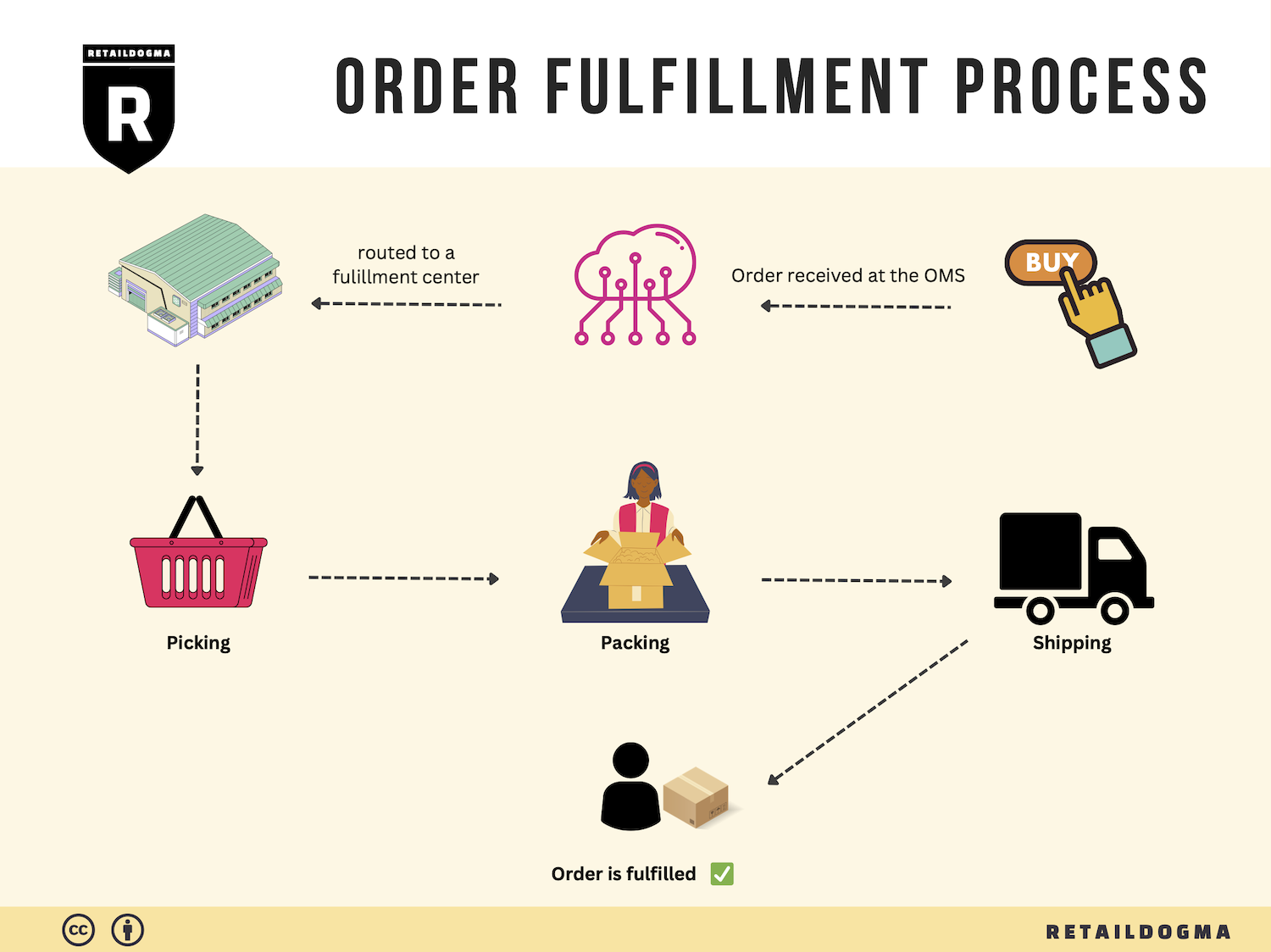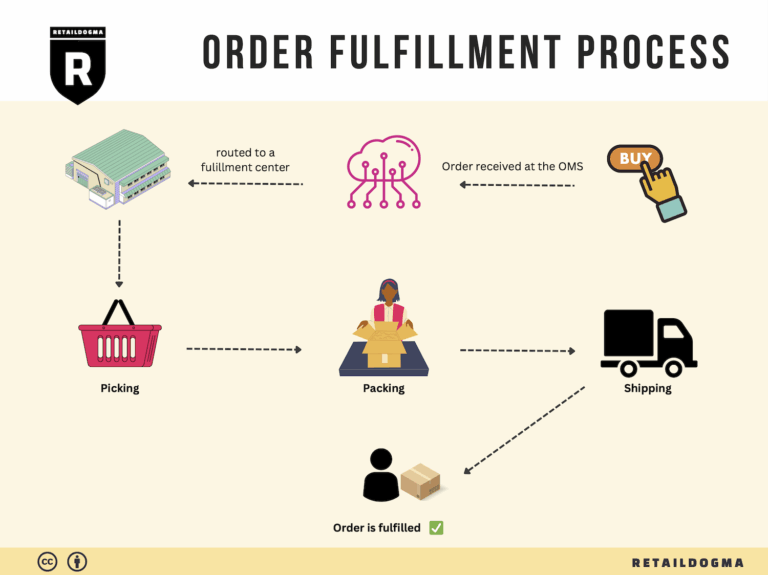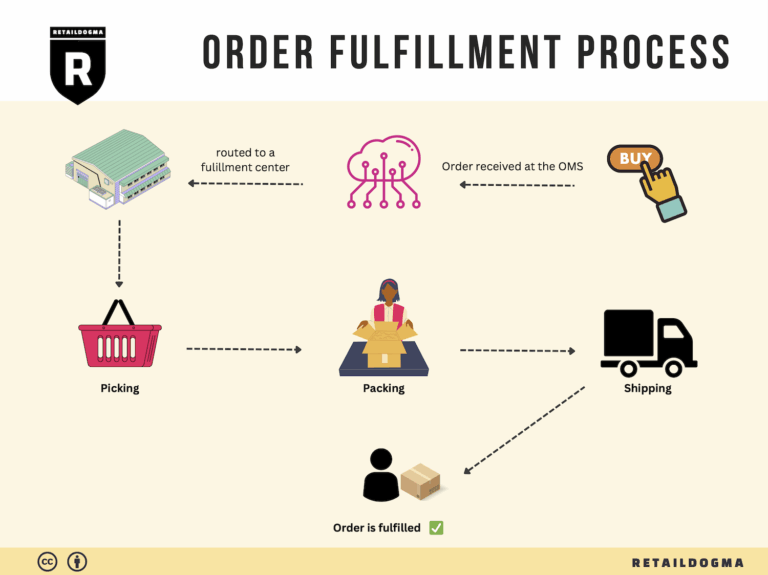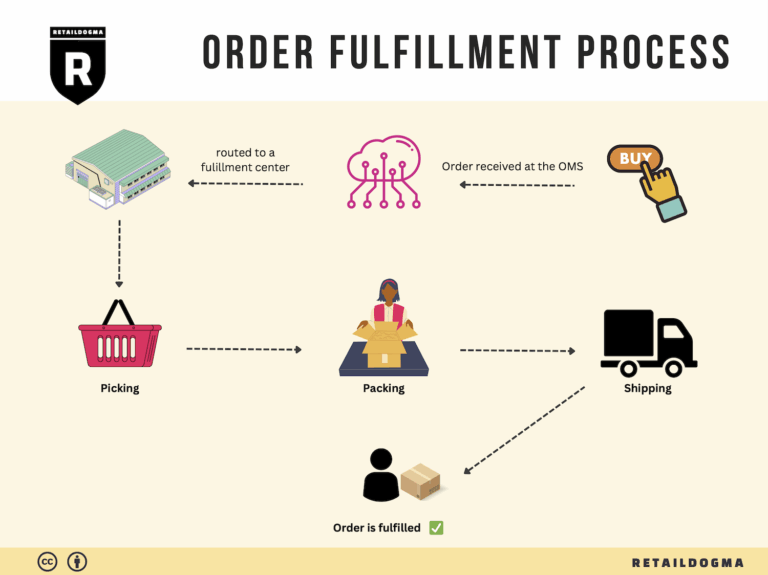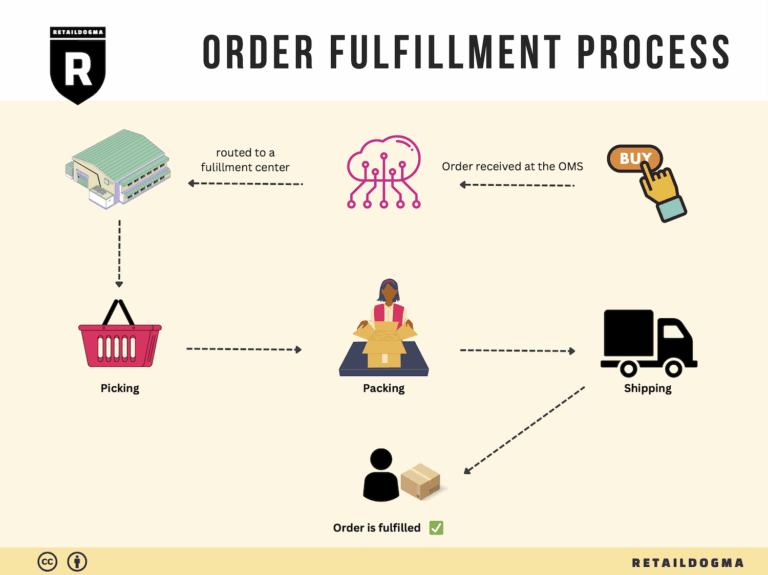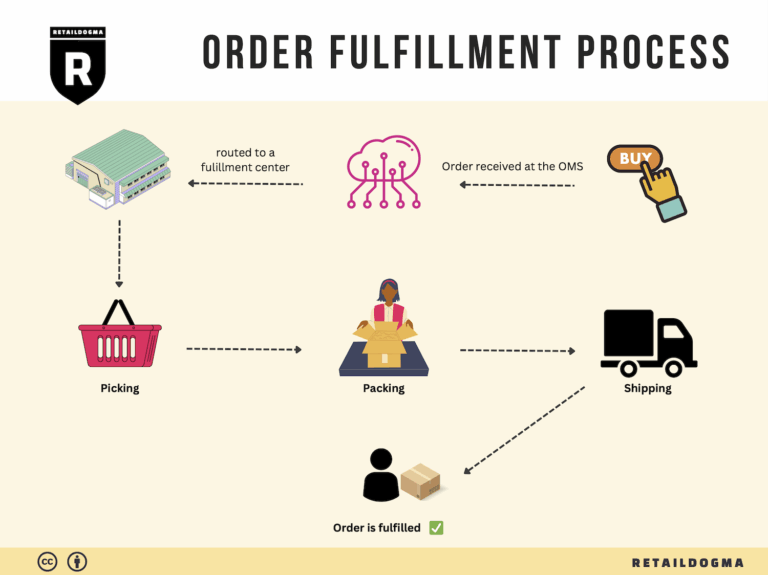Ecommerce Fulfillment Services: The Ultimate Guide (2025)
What is E-commerce Fulfillment? An Introduction for Growing Businesses
Understanding the Challenges of Order Fulfillment
As an e-commerce business owner, you may often find yourself overwhelmed with the complexities of packing and shipping orders. The excitement of making sales can quickly turn into a logistical nightmare, especially as your customer base grows. Managing inventory, ensuring timely deliveries, and maintaining a high level of customer satisfaction can be daunting tasks. This is where effective e-commerce fulfillment comes into play.
Defining E-commerce Fulfillment
At its core, fulfillment is the process of getting a product from your warehouse or store to your customer’s doorstep. This includes everything from receiving orders and picking items from inventory to packing them securely and shipping them out. Understanding the fulfillment process is crucial for scaling your business efficiently and effectively.
What This Guide Covers
In this comprehensive guide, we will explore various models of e-commerce fulfillment that can help streamline your operations. You’ll learn about:
-
Fulfillment Models: We will discuss different fulfillment options such as Third-Party Logistics (3PL), Fulfillment by Amazon (FBA), and in-house fulfillment. Each model has its own advantages and challenges, and choosing the right one can significantly impact your business.
-
Core Services: We will outline the essential services involved in e-commerce fulfillment, including inventory management, order processing, packing, shipping, and returns handling. Understanding these services will help you identify what you need from a fulfillment partner.
-
Choosing the Right Partner: Selecting the right fulfillment partner is a critical decision for any growing business. We will provide insights into the key factors to consider, such as location, technology, scalability, and customer service.
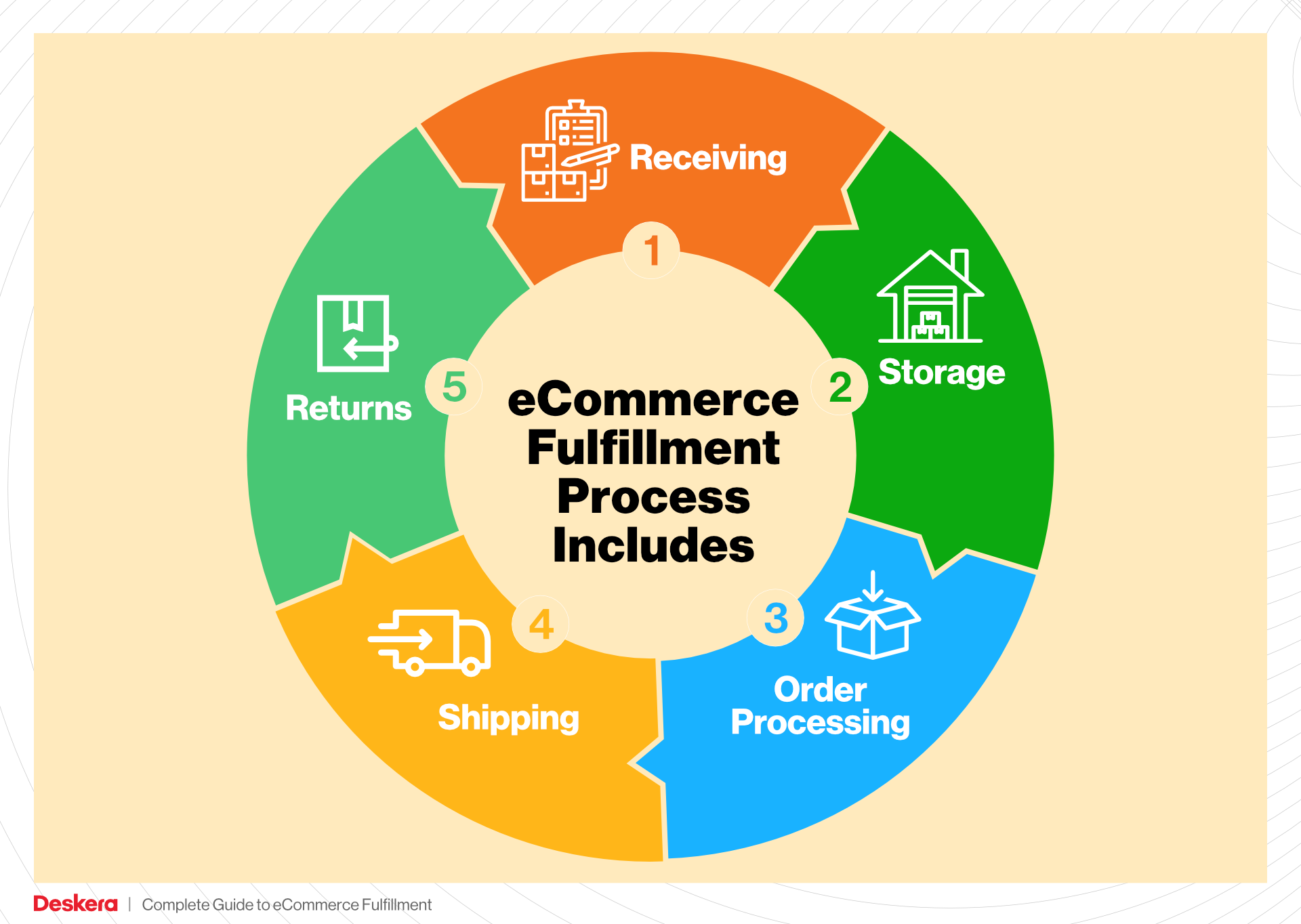
-
Pricing Structures: Fulfillment costs can vary widely based on the services you choose and the volume of orders you process. This guide will help you navigate different pricing structures to ensure you’re making a cost-effective choice that aligns with your business goals.
Empowering Your Business Decisions
The ultimate goal of this guide is to empower you to make informed decisions about your logistics and fulfillment strategies. By understanding the intricacies of e-commerce fulfillment, you can streamline your operations, reduce overhead costs, and enhance customer satisfaction—all essential elements for scaling your business successfully. Whether you’re just starting out or looking to optimize your existing processes, this guide will serve as a valuable resource on your journey to fulfillment excellence.
What You’ll Learn In This Guide
- What is E-commerce Fulfillment? An Introduction for Growing Businesses
- The Order Fulfillment Process: From ‘Buy’ Button to Customer’s Door
- Comparing Fulfillment Models: In-House vs. 3PL vs. Dropshipping
- A Deep Dive into Amazon FBA: Pros, Cons, and Who It’s For
- Core Services Offered by Fulfillment Centers
- How to Choose a Fulfillment Partner: A 6-Point Checklist
- Understanding Fulfillment Pricing: A Breakdown of Common Fees
- Frequently Asked Questions (FAQs) about Fulfillment
- Conclusion: Is Outsourcing Fulfillment the Right Move for Your Business?
- Important Disclaimer
The Order Fulfillment Process: From ‘Buy’ Button to Customer’s Door
1. Receiving Inventory
The order fulfillment process begins with receiving inventory, which is a critical step in ensuring that your e-commerce operations run smoothly. When products arrive at your fulfillment center, they must be checked for accuracy against purchase orders. This includes verifying quantities, inspecting for damages, and ensuring that the right items have been received.
Key Term: SKU (Stock Keeping Unit)
Each item should have a unique SKU, which simplifies tracking and inventory management. By efficiently managing SKUs, you can streamline the receiving process and maintain accurate records.
The importance of this step lies in its impact on inventory accuracy. Any discrepancies at this stage can lead to stockouts, overstock situations, or customer dissatisfaction due to incorrect orders. Effective receiving processes also help maintain a clean and organized warehouse, which is essential for subsequent steps.
2. Warehouse Storage
Once inventory is received and verified, it moves to warehouse storage. This step involves strategically placing products in designated areas within the fulfillment center. Efficient storage solutions, such as shelving, bins, and pallets, help optimize space and improve accessibility.
Key Term: ABC Analysis
This inventory categorization technique groups items based on their importance. ‘A’ items are high-value or fast-moving products, while ‘C’ items are lower-value or slow-moving. By applying ABC analysis, businesses can prioritize space and management efforts accordingly.

Effective warehouse storage is crucial for minimizing retrieval times during order picking. A well-organized storage system enables employees to quickly locate and access items, enhancing overall operational efficiency. Additionally, proper storage can help prevent product damage and spoilage, particularly for perishable goods.
3. Order Picking
The next step is order picking, where items are selected from storage to fulfill customer orders. This process can be done manually or through automated systems, depending on the scale and sophistication of the operation. Order picking typically involves generating a pick list, which details the items and quantities needed for each order.
Key Term: Pick List
A pick list is a document or digital tool that outlines the specific items required for an order, including their locations within the warehouse. It guides workers in efficiently gathering products.
The significance of order picking cannot be overstated; it directly affects order accuracy and fulfillment speed. Mistakes during this stage can lead to incorrect shipments, increasing returns and customer dissatisfaction. Implementing efficient picking strategies, such as batch picking or zone picking, can significantly enhance productivity.
4. Order Packing
After items are picked, they move to the order packing stage. Here, the selected products are prepared for shipment. This involves checking the items against the order to ensure accuracy, and then packing them securely for transport. Proper packing materials, such as boxes, bubble wrap, and packing peanuts, should be used to prevent damage during shipping.
Key Term: Packing Slip
A packing slip is a document included in the shipment that outlines the contents of the package. It serves as a confirmation for both the sender and the recipient, ensuring that all items have been included.
The packing process is vital for maintaining product integrity and customer satisfaction. Thoughtful packing not only protects items but also enhances the unboxing experience, which can lead to positive reviews and repeat business. Furthermore, accurate packing can streamline the shipping process, reducing delays.

5. Shipping & Delivery
The final step in the order fulfillment process is shipping and delivery. Once packages are packed, they are labeled and dispatched to the appropriate carriers for delivery. This step involves selecting the right shipping method based on factors like cost, speed, and destination.
Key Term: Last-Mile Delivery
Last-mile delivery refers to the final leg of the shipping process, where the package is delivered from a transportation hub to the customer’s doorstep. It is often the most complex and costly part of the shipping process.
Shipping and delivery are critical for customer satisfaction and loyalty. Timely delivery not only meets customer expectations but also enhances the reputation of your brand. Implementing technology solutions, such as real-time tracking and automated notifications, can improve the delivery experience and keep customers informed throughout the process.
By following these five essential steps in the order fulfillment process, e-commerce businesses can effectively manage their operations and scale their logistics to meet growing customer demands. Each step is interconnected, and optimizing them collectively leads to a smoother, more efficient fulfillment operation.
Comparing Fulfillment Models: In-House vs. 3PL vs. Dropshipping
Fulfillment Model Comparison Table
| Model | Who Handles Inventory | Best For (Business Stage) | Key Advantage | Key Disadvantage |
|---|---|---|---|---|
| In-House Fulfillment | Business itself | Established businesses | Greater control over inventory and process | Higher operational costs and complexity |
| Third-Party Logistics (3PL) | 3PL provider | Growing businesses | Scalable solutions and expertise | Less control over inventory and fulfillment processes |
| Dropshipping | Supplier | Startups and small businesses | Minimal upfront investment and risk | Potentially lower profit margins and quality control issues |
In-House Fulfillment
In-house fulfillment refers to a model where the business manages its own inventory, warehousing, and order fulfillment processes. This model is best suited for established businesses that have the resources and volume to justify the overhead costs associated with running a fulfillment operation. The key advantage of in-house fulfillment is the greater control it provides over the inventory and the entire fulfillment process. Businesses can directly manage stock levels, streamline picking and packing procedures, and ensure quality control. However, this model comes with significant disadvantages, including higher operational costs and complexity. Businesses must invest in warehouse space, staffing, and technology systems to effectively manage their fulfillment operations. Additionally, as order volumes fluctuate, in-house operations can become strained, leading to inefficiencies and potential customer dissatisfaction.
Third-Party Logistics (3PL)
Third-party logistics (3PL) involves outsourcing fulfillment operations to a specialized logistics provider. This model is ideal for growing businesses looking to scale without the burden of managing warehousing and distribution themselves. 3PL providers offer scalable solutions, allowing businesses to adjust their logistics capabilities based on demand fluctuations. The key advantage of using a 3PL is access to logistics expertise and advanced technologies that might be cost-prohibitive for smaller businesses to implement independently. However, the trade-off is a reduction in control over inventory and fulfillment processes. Businesses must rely on their 3PL partners to maintain quality and efficiency, which can lead to challenges if the 3PL does not meet expectations. Additionally, businesses may face complexities in communication and coordination, particularly if they work with multiple logistics partners.
Dropshipping
Dropshipping is a fulfillment model where the retailer does not keep products in stock but instead transfers customer orders directly to a supplier or manufacturer, who then ships the products directly to the customer. This model is particularly advantageous for startups and small businesses with limited capital, as it requires minimal upfront investment in inventory. The key advantage of dropshipping is the low financial risk; businesses only pay for products after they have been sold. This allows entrepreneurs to test new products and markets without significant financial commitment. However, dropshipping also comes with notable disadvantages. Profit margins can be lower compared to other fulfillment models, as suppliers often charge higher prices for dropshipping services. Additionally, quality control can be an issue, as businesses have little oversight over the products being shipped and the fulfillment process. This lack of control can lead to inconsistent customer experiences, potentially damaging the brand’s reputation.
Conclusion
When deciding on a fulfillment model, e-commerce business owners and operations managers must carefully consider their current business stage, resources, and long-term goals. In-house fulfillment offers the most control but can be costly and complex. 3PL providers present a scalable solution with logistics expertise but reduce control over processes. Dropshipping minimizes financial risk and allows for easy market testing but may compromise on profit margins and quality. Understanding these differences is crucial for making informed decisions that align with business objectives and customer expectations.
A Deep Dive into Amazon FBA: Pros, Cons, and Who It’s For
Understanding Fulfillment by Amazon (FBA)
Fulfillment by Amazon (FBA) is a service that allows sellers to store their products in Amazon’s fulfillment centers. Amazon then takes care of storage, packaging, and shipping of these products directly to customers. In addition to logistics management, FBA offers sellers access to Amazon’s customer service and returns handling. This comprehensive service enables businesses to focus on growth while leveraging Amazon’s extensive infrastructure.
How FBA Works
-
Setup: Sellers create an Amazon seller account and enroll in FBA. They can then list their products and prepare them for shipment to Amazon’s fulfillment centers.
-
Shipping Inventory: Sellers send their products to designated Amazon fulfillment centers. Amazon provides guidelines on how to package and label products to ensure they meet their requirements.
-
Storage: Once the products arrive at the fulfillment center, they are stored until sold. Amazon manages inventory levels, making it easier for sellers to keep track of stock.
-
Order Processing: When a customer places an order, Amazon handles the entire fulfillment process. This includes picking the product from the shelf, packing it, and shipping it directly to the customer.
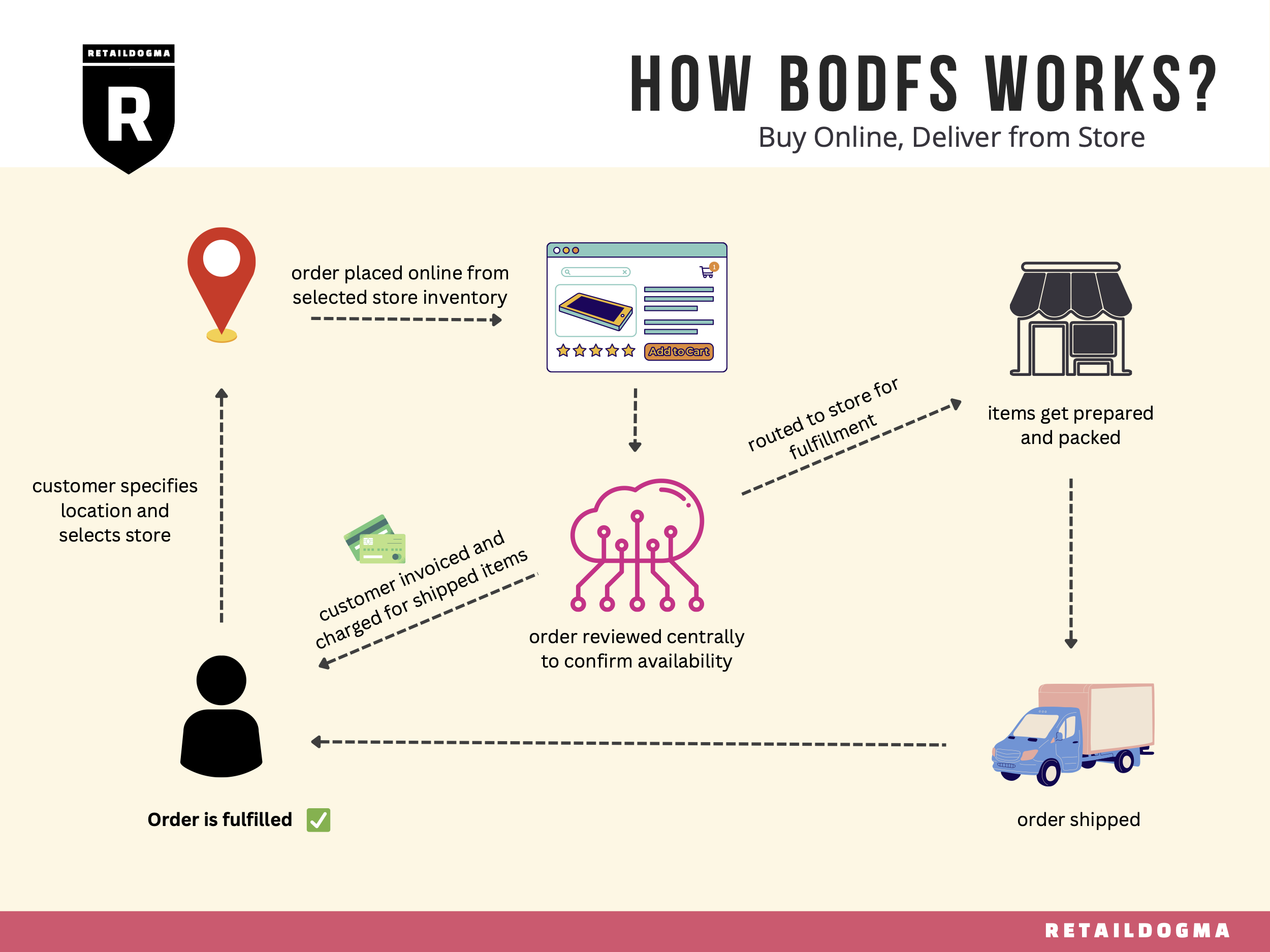
-
Customer Service and Returns: Amazon manages customer service inquiries and handles returns for FBA products, providing sellers with peace of mind and allowing them to focus on sales and marketing.
Pros of FBA
Prime Eligibility
One of the standout advantages of FBA is the ability to offer products with Amazon Prime eligibility. This can significantly increase sales, as Prime members tend to prefer products that can be shipped quickly and at no additional cost. With FBA, sellers can benefit from Amazon’s two-day shipping, enhancing customer satisfaction and loyalty.
Customer Trust
Amazon is a well-established and trusted marketplace. By using FBA, sellers can leverage Amazon’s reputation, which can lead to increased credibility and trust among potential customers. This is especially beneficial for new sellers who may not have an established brand presence.
Multi-Channel Fulfillment
FBA isn’t limited to just Amazon sales. Sellers can use FBA to fulfill orders from their own websites or other sales channels, allowing for a centralized inventory management system. This multi-channel fulfillment capability can streamline operations and enhance customer experience across different platforms.
Cons of FBA
High Fees
One of the significant drawbacks of FBA is the associated costs. Sellers must pay storage fees for their inventory as well as fulfillment fees for each item sold. These fees can accumulate quickly, particularly for products with slower sales velocity or those requiring long-term storage. It’s essential for sellers to calculate their margins carefully to ensure profitability.
Strict Inventory Rules
Amazon enforces strict inventory management policies that sellers must adhere to. This includes guidelines on product labeling, packaging, and the quantity of inventory allowed in fulfillment centers. Non-compliance can lead to additional fees or even the removal of inventory. Sellers must be diligent in managing their stock levels and ensuring that they meet Amazon’s requirements.
Commingling Risks
When sellers use FBA, their inventory can be commingled with that of other sellers. While this can streamline fulfillment, it also poses risks. If a customer returns a product, there’s a chance that the returned item may not belong to the original seller. This can lead to issues with product quality control and brand reputation. Sellers must weigh these risks against the benefits of using FBA.
Who is FBA Best For?
Fulfillment by Amazon is particularly beneficial for certain types of sellers:
-
Small to Medium-Sized Businesses: For businesses without the infrastructure to handle logistics, FBA provides an efficient solution. It allows these businesses to scale without the burden of managing warehousing and shipping logistics.
-
Sellers with High Sales Volume: Businesses that experience high sales volumes can benefit from the economies of scale that FBA offers. The per-unit fulfillment costs can decrease as order volume increases, improving overall profitability.
-
Sellers Looking to Expand Reach: For those looking to reach a wider audience, FBA is an effective way to tap into Amazon’s massive customer base. Sellers can benefit from increased visibility and exposure, leading to higher sales potential.
-
Businesses with Seasonal Products: FBA can be a strategic advantage for sellers with seasonal products. By utilizing Amazon’s logistics network, sellers can efficiently manage inventory peaks and troughs associated with seasonal demand.
In conclusion, Fulfillment by Amazon can be a powerful tool for e-commerce businesses looking to scale their operations efficiently. While it presents several advantages, such as Prime eligibility and customer trust, sellers must carefully consider the associated costs and operational challenges. Ultimately, FBA can be an excellent fit for small to medium-sized businesses, high-volume sellers, and those seeking to expand their market reach.
Core Services Offered by Fulfillment Centers
Inventory Management & Warehousing
Inventory management and warehousing are foundational services provided by fulfillment centers. This involves the systematic tracking and storage of products in a controlled environment, ensuring that goods are available when needed. Fulfillment centers utilize advanced inventory management systems that offer real-time visibility into stock levels, which is critical for any e-commerce business looking to scale operations.
Benefits:
-
Optimized Stock Levels: By maintaining accurate inventory records, businesses can avoid stockouts or overstock situations. This balance minimizes holding costs and ensures that customer demands are met promptly.
-
Space Efficiency: Fulfillment centers are designed to maximize storage space through strategic shelving and layout designs. This allows businesses to store a larger volume of products without needing to invest in additional warehouse space.
-
Reduced Operational Costs: Outsourcing inventory management to a fulfillment center can lower overhead costs associated with staffing, equipment, and facility maintenance. This allows businesses to focus resources on core activities like marketing and customer service.
-
Scalability: As e-commerce businesses grow, fulfillment centers can easily adapt to increased inventory needs without the complexities of relocating or expanding in-house operations.
Pick and Pack Services
Pick and pack services are integral to the fulfillment process. This service involves selecting items from the warehouse based on customer orders (picking) and then packaging them for shipment (packing). Fulfillment centers employ efficient picking strategies, such as batch picking or wave picking, to streamline the process and reduce order lead times.
Benefits:
-
Speed and Efficiency: Automated systems and trained personnel enhance the speed of order processing. Fulfillment centers can typically pick and pack orders faster than most in-house operations, leading to quicker delivery times and increased customer satisfaction.
-
Accuracy: With advanced technology, such as barcode scanners and inventory management software, the likelihood of picking errors is significantly reduced. This accuracy translates to fewer returns and greater customer trust.
-
Customization: Many fulfillment centers offer customizable packaging options, allowing businesses to enhance their brand visibility. This includes branded boxes, promotional inserts, and other personalized touches that can elevate the customer experience.
-
Scalability: As order volumes fluctuate, fulfillment centers can adjust their picking and packing resources accordingly. This flexibility is vital during peak seasons or promotional events when order volumes can surge unexpectedly.
Kitting and Assembly
Kitting and assembly services involve combining multiple products into a single package or assembling components into a finished product. This service is particularly beneficial for businesses that offer bundled products or need to prepare items for specific promotional events.
Benefits:
-
Streamlined Operations: By outsourcing kitting and assembly, e-commerce businesses can simplify their operations. Fulfillment centers handle the logistics of combining products, allowing businesses to focus on core functions like marketing and sales.
-
Cost Savings: Kitting can reduce shipping costs by consolidating multiple items into one package. This not only saves on shipping fees but can also lead to lower packaging costs.
-
Enhanced Customer Experience: Offering kits or bundled products can improve customer satisfaction by providing a curated shopping experience. Fulfillment centers can help businesses create unique product offerings that stand out in a competitive market.
-
Inventory Management: Kitting allows businesses to manage inventory more effectively by reducing the number of individual SKUs. This can lead to simplified inventory tracking and reduced carrying costs.
Returns Management (Reverse Logistics)
Returns management, or reverse logistics, is a crucial service that focuses on the process of handling returned products. A well-organized returns management system can significantly impact customer satisfaction and retention, as consumers expect a hassle-free return process.
Benefits:
-
Customer Satisfaction: A streamlined returns process enhances the customer experience, making it easy for customers to return unwanted items. Fulfillment centers often provide return labels and processing systems that simplify this task for the consumer.
-
Efficiency: Fulfillment centers can quickly assess returned items, restock them if they are in sellable condition, or manage the disposal of unsellable goods. This efficiency reduces the time and labor associated with returns, helping businesses maintain operational flow.
-
Data Insights: By analyzing return data, businesses can gain insights into customer behavior and product performance. Understanding why products are returned can inform future inventory decisions and product offerings.
-
Cost Management: Effective returns management can help businesses recapture value from returned products, whether through resale or recycling. This can mitigate the financial impact of returns and contribute to a more sustainable business model.
In conclusion, leveraging the core services offered by fulfillment centers can significantly enhance an e-commerce business’s operational efficiency, customer satisfaction, and scalability. By outsourcing these critical logistics functions, businesses can focus on growth and strategic initiatives while ensuring their supply chain remains robust and responsive to market demands.
How to Choose a Fulfillment Partner: A 6-Point Checklist
Location & Warehouse Network
Importance: The geographical location of your fulfillment partner’s warehouses can significantly impact shipping times and costs. A partner with strategically located facilities can ensure faster delivery to your customers, enhancing their experience and potentially increasing your sales.
Questions to Ask:
1. Where are your fulfillment centers located, and how does that align with my target market?
2. Can you provide insights on shipping costs and delivery times based on your current locations?
3. Do you have plans to expand your warehouse network in the near future, particularly in regions I serve?
Technology & Integrations
Importance: The technology stack of your fulfillment partner is critical for seamless operations. Advanced fulfillment centers use sophisticated Warehouse Management Systems (WMS) and offer integrations with e-commerce platforms, enabling real-time inventory updates, order tracking, and data analytics.
Questions to Ask:
1. What technology platforms do you use for order management, inventory tracking, and reporting?
2. Can your systems integrate with my existing e-commerce platforms (e.g., Shopify, WooCommerce, Magento)?
3. How do you handle data security and compliance, especially regarding customer information?
Specializations (e.g., Cold Storage, Oversized Items)
Importance: Depending on the nature of your products, you may need a fulfillment partner with specific capabilities. For instance, if you sell perishables, a partner with cold storage facilities is essential. Similarly, oversized items require specialized handling and storage solutions.
Questions to Ask:
1. What types of products do you specialize in handling, and do you have the necessary facilities for my specific needs?
2. Can you accommodate unique packaging requirements or special handling procedures for my products?
3. What experience do you have in managing inventory turnover for perishable or specialized goods?
Scalability & Capacity
Importance: As your business grows, so will your fulfillment needs. A partner that can scale operations quickly and efficiently is crucial to avoid disruptions. This includes having the capacity to handle seasonal spikes in demand without sacrificing service quality.
Questions to Ask:
1. How do you manage peak seasons, and what strategies do you have in place for scaling operations?
2. Can you provide case studies or examples of how you’ve supported other clients during periods of rapid growth?
3. What is the maximum capacity of your warehouses, and how do you plan to accommodate growth?
Pricing and Contracts
Importance: Understanding the pricing structure and contract terms is essential for budgeting and financial planning. Transparency in pricing helps avoid unexpected costs, and flexible contracts can provide the agility needed in a fast-paced market.
Questions to Ask:
1. Can you break down your pricing structure, including storage fees, picking and packing costs, and shipping rates?
2. What are the terms of your contracts, and are there any penalties for early termination or changes in service levels?
3. How do you handle pricing adjustments in response to market changes or increased service demands?
Customer Support & Reviews
Importance: Reliable customer support is a vital aspect of any partnership. A fulfillment partner should provide responsive and effective support to resolve issues quickly. Additionally, reviews and testimonials can offer valuable insights into a partner’s reliability and service quality.
Questions to Ask:
1. What level of customer support do you offer, and what are your response times for inquiries or issues?
2. Can you provide references or case studies from other clients in my industry?
3. How do you handle service disruptions, and what processes do you have in place for communication during such events?
Conclusion
Selecting the right fulfillment partner is a critical decision that can impact your e-commerce business’s success. By using this checklist, you can assess potential partners effectively and make an informed choice that aligns with your operational needs and growth ambitions. Remember to conduct thorough due diligence and seek partners who demonstrate a commitment to quality service and scalability.
Understanding Fulfillment Pricing: A Breakdown of Common Fees
Initial Setup Fees
Initial setup fees are typically charged by fulfillment centers to cover the costs associated with onboarding a new client. These fees can vary widely depending on the complexity of the client’s needs and the fulfillment center’s infrastructure. Common elements included in these fees are account setup, software integration, and training for staff.
For example, if your e-commerce platform requires custom API integrations to connect with the fulfillment center’s system, this could lead to additional technical charges. To calculate initial setup fees, fulfillment centers may consider the time and resources needed to get your account operational, which can range from a few hundred to several thousand dollars.
Receiving Fees
Receiving fees are charged when the fulfillment center accepts and processes your inventory. This fee is usually calculated based on the volume of items received or the time taken to unload and inspect shipments.
For instance, a fulfillment center may charge a flat rate per pallet or a per-item fee. If you send a truckload of products, the receiving fee might be lower on a per-unit basis compared to smaller shipments due to economies of scale. Understanding your shipping frequency and item volume will help in estimating these costs effectively.
Storage Fees (per pallet/bin)
Storage fees are incurred for keeping your inventory in the fulfillment center’s warehouse. These fees are usually calculated on a per-pallet or per-bin basis, with costs varying based on the size of the items and the duration of storage.
For example, a common structure might charge $15-$30 per pallet per month. If your products are large and take up more space, the storage fees can accumulate quickly. Additionally, some fulfillment centers offer tiered pricing based on volume, so larger clients may benefit from reduced rates. Businesses should analyze their inventory turnover rates to avoid unnecessary storage fees.
Pick & Pack Fees (per item/order)
Pick and pack fees are charged for the labor involved in selecting items from storage and preparing them for shipment. This fee is typically calculated either per item or per order.
For instance, a fulfillment center may charge $1.00 per item picked and packed, or $5.00 per order regardless of the number of items. The complexity of the order can also impact these fees; orders requiring special handling or packaging may incur higher fees. To manage costs, businesses should strive for efficient order sizes and consolidate orders when possible.
Shipping Fees
Shipping fees represent one of the most significant costs in the fulfillment process. These fees are calculated based on several factors including the weight and dimensions of the package, shipping destination, and the chosen carrier service.
Fulfillment centers typically negotiate shipping rates with carriers, and these savings can be passed on to clients. Businesses should inquire about the fulfillment center’s shipping partnerships to ensure they are getting competitive rates. Additionally, understanding the various shipping options available—standard, expedited, or same-day delivery—can help businesses optimize their shipping strategy and costs.
Tips for Getting an Accurate Quote
-
Provide Detailed Information: When requesting a quote, be as detailed as possible regarding your product types, volumes, and order frequency. This information enables fulfillment centers to provide a more accurate estimate.
-
Ask About Hidden Fees: Inquire about any potential hidden fees that may arise during the fulfillment process, such as return processing or additional packaging costs.
-
Negotiate Terms: Don’t hesitate to negotiate terms based on your expected volume. Many fulfillment centers offer discounts for higher volumes or long-term contracts.
-
Request a Breakdown: Always ask for a detailed breakdown of all fees associated with the fulfillment services. This will help you understand where your costs are coming from and identify areas for potential savings.
-
Evaluate Service Levels: Understand the service levels you need. If you require faster processing or specialized services, ensure these are factored into the quote.
By thoroughly understanding these common fees and following the tips outlined, e-commerce businesses can make more informed decisions about their fulfillment strategy, ultimately leading to better profitability and customer satisfaction.
Frequently Asked Questions (FAQs) about Fulfillment
1. What is an H-E-B fulfillment center?
An H-E-B fulfillment center is a dedicated facility designed to manage and execute e-commerce orders for H-E-B’s grocery products. These centers are strategically located to support efficient order processing, including curbside pickup and home delivery services. They are stocked with a wide variety of products found in H-E-B stores and utilize automated systems to enhance order picking and packing efficiency.
2. How do H-E-B fulfillment centers differ from traditional warehouses?
While both fulfillment centers and traditional warehouses store goods, fulfillment centers are specifically designed for order processing and shipping. They focus on speeding up the delivery of products directly to customers, whereas warehouses primarily serve as storage facilities without a direct focus on e-commerce logistics. Fulfillment centers often incorporate advanced technologies for inventory management and order fulfillment to enhance efficiency.
3. What types of services do H-E-B fulfillment centers provide?
H-E-B fulfillment centers offer several services, including:
– Order Picking and Packing: Efficiently selecting and packaging products for e-commerce orders.
– Curbside Pickup: Preparing orders for customers to collect directly from the store.
– Home Delivery: Managing logistics for delivering groceries directly to customers’ homes.
– Inventory Management: Monitoring stock levels to ensure product availability and reduce congestion in physical stores.
4. How many fulfillment centers does H-E-B currently operate?
As of now, H-E-B operates multiple fulfillment centers across Texas, with plans for further expansion. These centers enhance H-E-B’s capacity to serve the growing demand for online grocery shopping, with facilities tailored to specific metropolitan areas to improve service delivery.
5. What is the average cost of fulfillment services?
The cost of fulfillment services can vary widely based on several factors, including the volume of orders, types of products, and specific service requirements. Generally, businesses can expect to pay for storage, order processing, and shipping fees. It’s advisable for e-commerce businesses to obtain quotes from multiple providers to ensure competitive pricing and suitable service levels.
6. How does H-E-B ensure product availability in its fulfillment centers?
H-E-B utilizes advanced inventory management systems that track stock levels in real-time, allowing them to maintain optimal inventory and reduce stockouts. The fulfillment centers are strategically stocked with products based on customer demand and purchasing trends, ensuring that popular items are readily available for online orders.
7. What is a Third-Party Logistics Provider (3PL)?
A Third-Party Logistics Provider (3PL) is a company that offers outsourced logistics services to businesses. This can include warehousing, order fulfillment, transportation, and distribution. Businesses often partner with 3PLs to enhance their supply chain efficiency, reduce costs, and focus on core operations, leaving logistics management to specialized providers.
8. How can businesses benefit from using H-E-B fulfillment centers?
Businesses can benefit from utilizing H-E-B fulfillment centers through:
– Improved Delivery Times: Enhanced logistics capabilities lead to faster order fulfillment and delivery.
– Reduced Operational Costs: By outsourcing fulfillment to H-E-B, businesses can save on warehousing and staffing expenses.
– Increased Customer Satisfaction: Efficient order processing and delivery contribute to a better shopping experience for customers.
9. What technologies are used in H-E-B fulfillment centers?
H-E-B fulfillment centers employ various technologies, including:
– Automated Picking Systems: To streamline the selection process and reduce errors.
– Inventory Management Software: For real-time tracking and management of stock levels.
– Routing Software: To optimize delivery routes and enhance logistics efficiency.
10. How can businesses scale their operations using H-E-B fulfillment centers?
To scale operations using H-E-B fulfillment centers, businesses should:
– Integrate E-commerce Platforms: Ensure their online store seamlessly connects with H-E-B’s systems for smooth order processing.
– Analyze Customer Demand: Utilize data analytics to understand purchasing patterns and adjust inventory accordingly.
– Leverage H-E-B’s Network: Take advantage of H-E-B’s extensive distribution network to reach more customers efficiently and effectively.
By understanding these key aspects of H-E-B fulfillment centers, e-commerce business owners can make informed decisions that support their growth and operational efficiency.
Conclusion: Is Outsourcing Fulfillment the Right Move for Your Business?
Evaluating the Benefits of Outsourcing Fulfillment
Outsourcing your fulfillment can be a transformative decision for your e-commerce business, offering a multitude of benefits that can significantly enhance your operations. First and foremost, partnering with a fulfillment service can save you valuable time. By delegating order processing, inventory management, and shipping logistics to a dedicated provider, you can focus on core business activities such as product development, marketing, and customer engagement. This allows you to allocate resources more efficiently and accelerate your growth trajectory.
Scalability is another compelling reason to consider fulfillment outsourcing. As your business grows, so do your operational demands. A proficient fulfillment partner can easily adapt to fluctuating order volumes, ensuring that you can meet customer expectations without the need for substantial investments in infrastructure or staffing. This flexibility not only supports your immediate needs but also positions you well for future expansion in new markets.
Expertise is a crucial factor as well. Fulfillment centers often come equipped with advanced technology and industry know-how, which can enhance your shipping efficiency and accuracy. They can help you navigate complexities such as international shipping, customs regulations, and inventory optimization, ultimately leading to improved customer satisfaction and retention.
However, the choice of a fulfillment partner is critical to your success. Conduct thorough research to find a provider that aligns with your business goals and values. Look for partners who demonstrate a proven track record, offer transparency in their processes, and provide reliable customer service.
Take Action Today
To determine if outsourcing fulfillment is the right step for your business, consider conducting an audit of your current shipping and logistics processes. Evaluate the time and resources you spend on fulfillment versus the potential benefits of partnering with a specialized provider. Taking this strategic step could position your business for sustainable growth and enhanced operational efficiency.
Important Disclaimer
⚠️ Important Disclaimer
The information in this guide is for educational purposes. Fulfillment services, pricing, and platform features change frequently. Always conduct your own due diligence and consult with providers directly before making business decisions.
